The Basics of Feline Color Genetics
Extension
As with all mammals, cats produce two types of pigment: eumelanin (black) and phaeomelanin (red/yellow). These pigments are mixed and matched with dilutions, modifiers, and white patterns to produce the rainbow of colors seen in the domestic cat. One of the genes that controls the switch between black and red pigment is MC1R, otherwise known as extension. Although in other species, many mutations in MC1R are known to exist, in the domestic cat there is only one known mutation of extension. This mutation creates what is known as Amber coloration. Currently, it is only found in Norwegian Forest Cats. This mutation results in kittens born expressing eumelanin (black pigment); but as they mature the pigment changes to phaeomelanin (red/yellow pigment), resulting in a red or yellow cat. These cats can look very similar to orange/ginger cats, but the mechanism is different and they often retain some black pigment at the tip of the tail and the paws. The amber mutation is recessive and does not affect skin coloration. It is still possible that other extension mutations exist, they have not yet been located. For most purposes, it can safely be assumed that all cats that are not from Amber lines are [b]EE[/b] at extension.
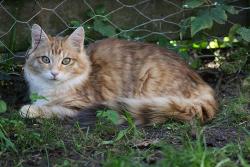
Amber mackerel tabby at 6 months in mid-color change. Open Source Photo
Amber cat with her litter of Amber kittens. This photo shows the dark color the kittens are born. Open Source Photo
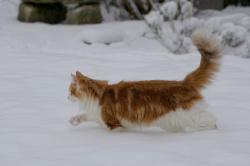
Amber blotched tabby as an adult. Open Source Photo
Agouti
Agouti ([b]A[/b]) controls whether a cat is self-colored (solid) or striped. Cats that lack agouti are [b]aa[/b] and will usually be solid colored (although sometimes "ghost" striping can be seen). Cats that carry at least one [b]A[/b] allele will exhibit a striped, or ticked appearance, depending on which modifiers are present. It is probable that the [b]aa[/b] cat is not a cat without stripes, but instead a cat with a base color that has been darkened to match the stripes. This can been seen in the orange cat, because the gene that causes orange limits the expression of [b]aa[/b]. This results in orange [b]aa [/b]cats that are still striped.
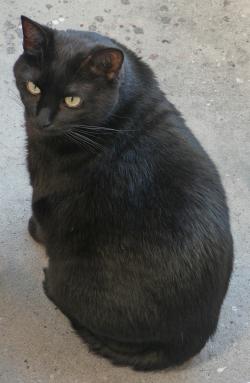
A solid (self colored) cat. Self colored cats are negative for agouti ([b]aa[/b]) Open Source Photo
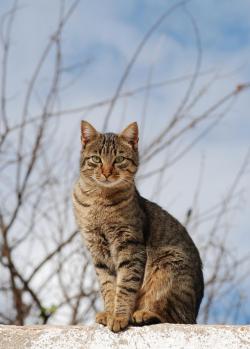
A mackerel tabby cat displaying the stripes that are "switched" on by the presence of Agouti. Open Source Photo
Ticking
There are several different modifiers that control how agouti expresses. The most current research on these modifiers has mapped the Ticked locus (Ti) to chromosome B1. The Ticked locus contains two alleles: [b]Ti[sup]A[/sup][/b] (ticked) and [b]Ti[sup]+[/sup][/b](non-ticked). Ticking does not mask the presence of the tabby genes but, rather, reorganizes the pigment from the stripes into "ticks". This reorganization starts at the body and works outward. Since Ticking is a semi-dominant trait, cats with two [b]Ti[sup]A[/sup][/b] alleles are affected more than cats with only one ticked allele. Generally, cats that are heterozygous for ticking will have residual stripes along the legs. If a cat does not carry a ticked allele, then the more common tabby colors are allowed to express. Because regular tabby does not express in the presence of ticking, all of the remaining tabby variants are [b]Ti[sup]+[/sup]Ti[sup]+[/sup][/b] at the Ticked locus.
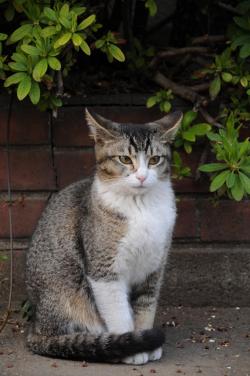
A ticked tabby with residual markings. It is quite possible that this cat is [b]TiATi+[/b] because of the stripes that are still visible. Open Source Photo
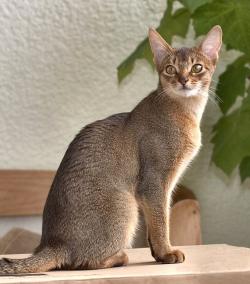
A ticked tabby. Open Source Photo
Tabby
The Tabby ([b]Ta[/b]) locus (sometimes seen as Mc, but I have chosen to go with the notation suggested by the researchers) has been mapped to chromosome A1. It contains the alleles [b]Ta[sup]M[/sup][/b] and [b]ta[sup]b[/sup][/b]. The [b]Ta[sup]M[/sup][/b] allele is the traditional mackerel tabby pattern with narrow stripes. The[b] ta[sup]b[/sup][/b] allele is the blotched tabby pattern. Blotched tabby is recessive to mackerel tabby; and instead of narrow stripes, the cat will have wide, sweeping ribbons of darker color. An additional tabby pattern is spotted. Because no additional tabby alleles have been located at the [b]Ta[/b] locus, it is probable that the spotted pattern is caused by yet another modifier, one that affects the Mackerel pattern by breaking it into spots. The spots can be completely colored, or hollow in the middle. When they are hollow they are known as "halos".
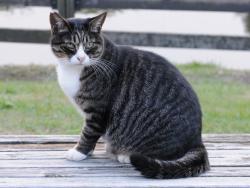
A dark mackerel tabby. Open Source Photo
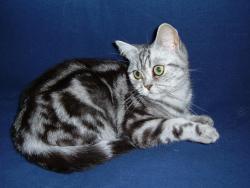
A blotched tabby cat. Blotched is recessive to mackerel Open Source Photo
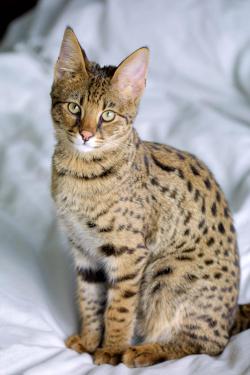
A spotted tabby Savannah cat. Open Source Photo
Comments Page
so if the tabby genes are
so if the tabby genes are inherited separately from the actual agouti gene that makes them work, would the tabby genes (without agouti) cause the "Ghost Striping" in black cats?
I have a number of black kitties, and in the right light, two of them have what looks exactly like tabby stripes on their heads and lower legs. It seems to actually be the pigment of the fur rather than just the part of the hair, and only two of the black cats have it. One of the two also happens to have a grey tabby as a sister...
Is the ghost striping just a natural thing in black cats, and unrelated to genetics?
Pattern in genetically "solid" colored cats
Ghost pattern is common in solid color, or non-agouti, (aa) cats. It is most pronounced in red and cream cats, where it can take some level of expertise to even tell an agouti (A_) cat from a non-agouti cat. In dilutes (blue and lilac, ghost pattern is often visible, as well as in smokes, and sometimes in even in solid blacks.




Question about agouti
Is "agouti" in cats inherited separately from from the ticking and tabby coloration? You seem to be referring to the various tabby and ticking patterns as modifiers of the agouti gene.
If so could a cat without the dominant agouti allele carry a tabby allele or a ticking allele?